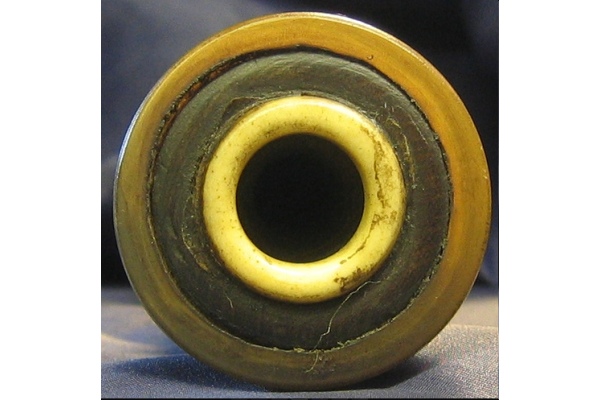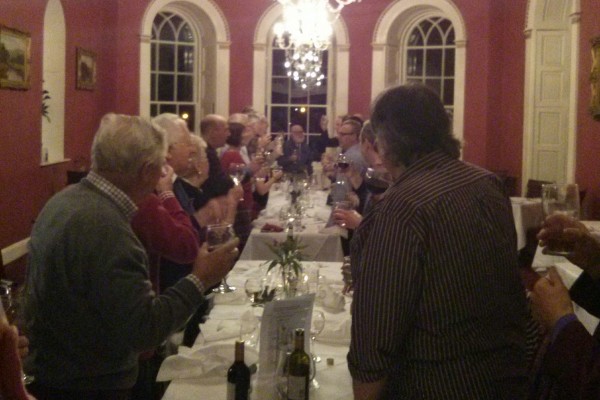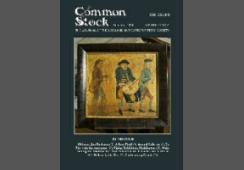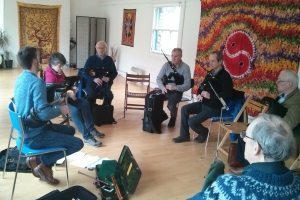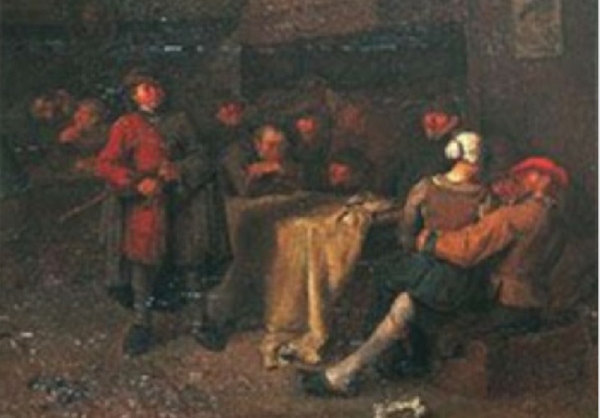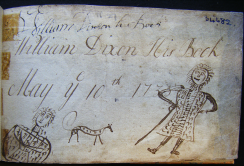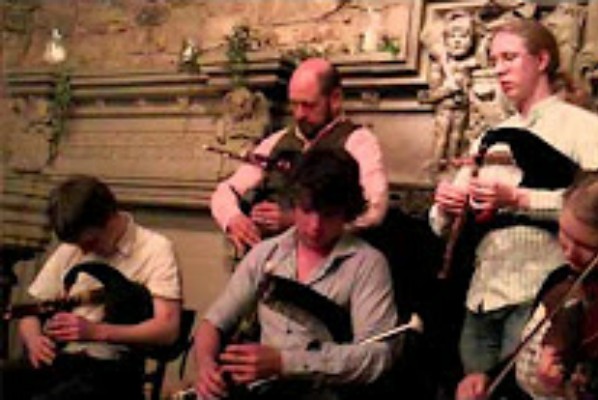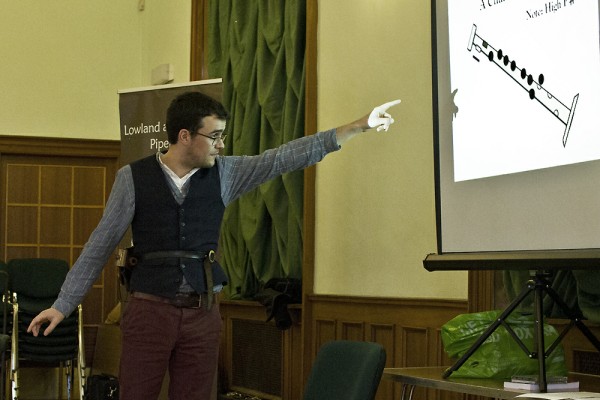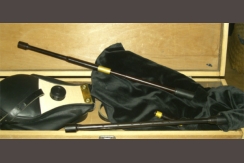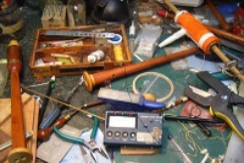The First speaker of the afternoon session was Chris Ormston, a leading proponent of the Northumbrian Smallpipes, and part of a continuous tradition of variation playing that stretches back into the 18th century
Matt opened his talk by saying that he had come up that morning on the new Border railway, the first time he’d been on it, and that the first tune he would play was ‘Braw, Braw Lads o Gala Water’; the railway, he explained, follows the Gala Water for much of its length, and the lyrics of the song are a journey, talking of all the pele towers along the way, strongholds of the Pringle family in the Borders - Scotland’s Eden. The tune is one that you’ll know Robert Burns wrote words to, but there were lyrics to it before that; those are the ones that mention all the place names. The tune takes its journey. I didn’t want to talk about it beforehand, I just wanted to play it, but Barnaby brought up such a relevant point that I’ll mention it. It’s the idea of going in and out with the drone. I like to just listen to the tune and let it sing, but from a technical point of view, it works on a two-against-two ratio, so it has two bars with the drone and two bars away from it, back and forth; and each verse is made up of twice 2:2, and the whole tune has four strains, not strict tempo, but you can hear the harmony changes. [Here Matt played the tune.]
A little bit of background to my approach to the Border repertoire and its relation to theme and variations now. Probably most of you will have some acquaintance with the William Dixon collection. In the most recent edition of the book that I produced I added an appendix, ‘Harmonic Proportion’ where I went into quite a lot of detail about the grounds that Dixon and others used for constructing tunes, so I don’t want to go into this very technical detailed stuff, at the moment anyway; I’ll give you more of the general gist of it, I’ll just read a paragraph and a bit: “If we may speak of the Dixon repertoire as a foundation, then the foundation of this foundation is that the tunes are built on harmonic patterns. This feature is shared by many musical idioms, from baroque to blues to bebop, but did not become consciously embedded in any of the uninterrupted piping traditions - that word ‘consciously’ is very important - perhaps because those who understood it instinctively simply assumed that everyone else did. The Dixon music, along with the music of some 17th and early 18th century English and Scottish fiddle composers, is a musical borderland, the interface of native melody with contemporary baroque. This ‘baroque sauvage’ - wild baroque - blended with the mainstream of Scottish music - and this is very important to know, if all you’ve heard of Scottish music is what you’ve heard since you were alive, you’ve missed an awful lot of the story. Throughout the 18th century there were reams and reams of tunes with variations written down, by a relatively small number of people, but it was a flourishing culture in which tunes were copied from one manuscript to another, they appeared in a series of printed books and it was on the go for most of the 18th century, this variation tradition, in Lowland Scotland. {Here Matt was reading from the introduction in his most recent publication ‘Geordie Syme’s Paircel o’ Tunes’}

So, this ‘baroque sauvage’ - wild baroque - blended with the mainstream of Scottish music, but was to lose potency as the 18th century waned. Perhaps its last visible surfacing was in Robert Riddell’s ‘Scotch, Galwegian and Border Tunes’ published in Edinburgh in 1794, which along with John Peacock’s ‘Favorite Collection’, published in Newcastle in 1800 or thereabouts, with which it shares some tunes, provided the best window on historical Border piping before the Dixon music came to light. This is borne out by Gordon Mooney’s books, Gordon drew heavily on Riddell’s book and a little bit also on Peacock’s.
After the 18th century there remained little visible evidence that this current had ever flowed north of the Border, but it retained its force amongst smallpipe players on Tyneside, and in south-east Northumberland, and in Cumbria, with the Clough family maintaining an underground pipeline from the time of the Allans, ‘the earliest pipers, Mr Scott says, of the Scotish Border, properly speaking’ to pipers still living, one of whom is in this room.
So there is, very tenuously, a link going way back to the Dixon tunes and the people who were playing them to the present day, and it is the south-of-the-border connection that has kept that music, that idiom, going.
There’s one tune in the Dixon manuscript which never went out of fashion and has been played more or less the same for nearly three hundred years: it’s ‘The Apprentice Lads of Alnwick’. Every Northumbrian piper knows it, and it’s pretty much the same now as it was then. So we’re not talking about reinventing the wheel - we’re talking about getting back on the train and carrying on where those people left off, and where some people have never stopped.
Now one thing about the tune I played, which is important to bear in mind [here Matt pointed up to the image of Geordie Syme displayed on the LBPS banner behind him], this guy’s been bugging me for a long, long time. If we read what is known about him we find that Thomas Scott, who was Sir Walter’s uncle, and who lived at Monklaw, in his conversation with Alexander Campbell, which is well known and well-documented - he said of George Syme “He is supposed to have been born and bred in one of the Lothians; He knew the art of producing the high octave by pinching the back hole of the chanter, which was reckoned a great improvement” - keep that in mind, “reckoned a great improvement” - “he was the best piper of his day. He lived about the middle of the 18th century.”
Well, what happened? How did that get lost? Why aren’t we all doing it? We’ve got this logo, we’re all looking to Geordie Syme, but we’re not playing the tunes he would have played, using that technique. This came right home to me when I was living in Gala, because the town’s most famous tune is the ‘Soor Plums o Galashiels’ and I felt I couldn’t look at myself in the shaving mirror if I couldn’t play this tune. And so I set to work on learning how to do that. The thing is, I came to piping very late, I was in my 40th year before I played pipes at all; if I can do it, any of you could, so please don’t be intimidated, don’t be put off.
In some ways Soor Plums isn’t a typical Border tune, with a melody sitting on top of a simple harmonic foundation, but to go back to variations: the basic reason that you have variations is that if you like something, if you love it, you want there to be more of it. It’s that simple. It was David Johnson that put this across to me very simply: a pupil of his asked him “Do you write the kind of music you write because you wish there were more of that kind of music?” and he said, “Yes I suppose I do.”
It’s the same with Soor Plums or the Braw Lads o Gala Water; they’re great tunes in the first place, so the reason you write variations is because you want more of them - it’s not enough to have a slice, you want a whole plateful.
So that‘s the basic logic - not logic, motive - behind variations, but as we know, and as Barnaby intimated, the quality is very important, we don’t just want quantity. So all the things he mentioned, like contrast, using the language that you’ve got, and originality, all come into play. And one thing I find a weakness of Mr Dixon’s book - its great strength is that it sets out how you do this stuff, how you write variations - the weakness to me is that some of it is a bit samey, so as Barnaby says, try and balance the variations within the tunes, because when I first got interested in this music, largely through hearing Chris (Ormston) play, I acquired a copy of this, Peacock’s ‘Favorite Collection’, published around 1800 [Matt held up a well-used copy of the book] and you can see that I’ve loved this book - it’s falling apart. I used to take this to bed with me and read it before switching the light off, because I couldn’t get my head round it - you’d have all these notes, how could you tell one tune from another? Because they all looked the same. It’s like, a dance-band musician said to me once “these classical guys, they can read fly-shit”. Well, this is like that - lots and lots and lots of notes. There were two tunes in particular that I just couldn’t tell apart, ‘Felton Lonnen’ and ‘Newmarket Races’. I can tell them apart now, but what I‘m trying to get across is the idea of familiarity. If I was to hear a recital of Chinese poetry - it wouldn’t be nonsense to the person who was reciting it, but it would be nonsense to me. You do have to familiarise yourself with it, to learn tha language, to get the most out of it, and that’s a journey that not everyone wants to take, and I do appreciate that; life’s very full, we all have other things to do as well, but I’ve found it to be a fascinating journey.
What I’ll do now is I’ll play a tune where the ethos behind the variation is very simple - it’s a melodic variation, which means that I keep the outline of basic tune all the time but I put a lot of filigree around it. It’s a tune everybody knows but nobody knows where it came from, it’s the one that Dick Gaughan uses for the Burns song ‘Now Westlin’ Winds’. I did ask Dick, where does that tune come from, and he didn’t know, but since he made it popular everyone else that sings the song uses that tune, rather than the tune it’s published with in the ‘Scots Musical Museum’. [Here Matt played the tune.]
Most of the Dixon music is kind of dance-based; we don’t know if it was necessarily played for dancing but I think probably a lot of it was. When you get this variation technique applied to dance tunes there are a lot of things that come up, a lot of phrases and ideas that come up again and again, and the trick with writing a good set of variations is not to be too formulaic; it’s to try and have a balance between form - it’s got to have some kind of shape - and formula. If it’s formula, and you know exactly what’s going to come next, just as Barnaby said, it’s pretty boring. So you want to have a contrast which you might not expect, or you want to appreciate the curve of the tune, how it’s making its journey.
The next tune I’d like to talk about is intimately connected with my friend Bill [Telfer], who’s sitting across there. It’s “Weel Bobbit Blanche of Middlebie”. Bill and I were exploring the tunes of the West Border, of Langholm where Bill lives, and the tune that had always stumped us was this one. One day we were playing it from the Riddell collection and it just suddenly clicked into place. Bill said to me, I wonder if we can find out anything about Blanche by going to Middlebie? And so we hopped in the car. Middlebie is just a spot on the map - a cross-roads, a few houses, a community centre, and not much else. So we went along to Ecclefechan nearby, and there we met the lady in the Thomas Carlyle Birthplace Museum and said - Bill that rang the bell, the place was actually closed that day - “It sounds crazy,” we said, “but we’re looking for Blanche of Middlebie”. “Oh Blanche”, she says, “I know Blanche.” She knew the direct descendant of Blanche of Middlebie, a sweet, elderly lady called Blanche Armstrong who can trace her ancestry back to the Bells who are a big family in that area.
So having no-one else to tell us what to do, Bill and I thought it would be a good wheeze to get a bunch of people together and play the tune for Blanche of Middlebie and we did that in Middlebie in 2011. This is all documented online and it’s summarised in this new book where I give the fuller version of the tune. Now the thing about this tune, the story that goes with it that Riddell records describes it as a dance tune - that’s the whole point - weel bobbit, she danced to this tune and at the end, King James or King Charles, or whoever it was, says “Weel Bobbit, Blanche of Middlebie!” So we know it’s a dance tune, but it’s got these runs in it, the runs that we’re getting in the Dixon tunes. So we have to ask, ‘can you do it?’ I think the answer is, that you can do it, you wouldn’t take it as fast as a flat-out, pub-session jig, but you wouldn’t take it as leisurely as some of the Dixon tunes.
When I realised I could find a way into this tune - and I’d been looking for one for a long time and failing to find it - several new strains appeared under my fingers; it wasn’t lot of effort. But the art was in sequencing these new strains.
The Blanche tune has five strains and most of the stuff we do works in twos, fours, sixes and eights, but this has got five. The first strain is mainly at the bottom of the chanter, the C#, the E, the low A. The second strain plays a lot with the combination of the C# and the high A. The third strain uses one of the standard filigree figures at the top of the chanter. The fourth strain develops the second, using the same ingredients. The fifth strain goes back to the C# and low A, but in a much more intense fashion, quicker notes. This strain has the Dum-diggadigga figures called ‘killywimples’, a Scots word meaning a decoration. So you’ve got strains that are low, middle, high, middle, low. [Here Matt was holding up his right hand, palm forward, fingers spread for the first five strains]; I had four new strains, and I didn’t have to think about it once I realised the arc of the tune. It was like that [Here Matt added four fingers of his left hand]. It goes through to the end - up, down, up, down - and it stops. It’s not like those tunes that I’ve played before where you go back to the melody. Maybe in another two hundred years someone will know things that I certainly don’t know and will add another arc and they’ll make a Trimontium out of it - who knows. But the tune has this arc, and the interesting thing is that I didn’t find this out until we made the contact with the person and the place and brought it back to life.
[Matt then played the tune through.]
If anyone knows Ben Power, Sean-nós Irish dancer, he danced the jig for Blanche in Middlebie. There were six pipers playing, so it was a bit slower than I played it, but he heroically managed to slow his dance down so that he could dance at the same tempo as the pipers played.
[Matt then went on to talk about some ‘key ideas’, and played some ‘killywimple’ phrases.] Those runs, they’re the kind of filler that you get all the way through the older Border tunes, the same with arpeggios. I tend to think of arpeggios as the carbohydrate of the variation set - it’s bulk. What I like to do with this bulk is to put a bit of spice into it. You’ve got to have the arpeggios - you need your carbohydrates, but they don’t have to be just [here Matt played basic three-note arpeggios]. They can be something a bit more interesting than that. So one of the things that I’ve done with my practice, which I do claim is a direct continuation, from hints in Peacock, Clough and from Chris, is to spice up these arpeggios and make them more interesting. This first came about with a tune that I gravitated toward in this book [Matt’s copy of Peacock], ‘Cuckold Come Out of the Amrey’ (= cupboard, armoire) which is why I’ve given this talk the title “Can Variations Come Out of the Amrey?” - because when you’re playing variations it’s a bit like, you’re doing a suspect practice which you shouldn’t mention in polite company. Well, I play variations; I’m out and I’m proud!
The thing I noticed about the Cuckold tune, again, it has a form to it. It’s derived from the Scottish fiddle strathspey ‘Struan Robertson’s Rant’, there’s a Highand pipe version of it called ‘The Red-Haired Girl of Tulloch’, but the Northumbrian version is called ‘Cuckold Come Out of the Amrey’ and there’s all kinds of theories about how it got its name. I’ll let you make up your own.
[Here Matt played the first strain of the tune.]
That first strain has a feeling of the modal centre being on the B, the note above the tonality of the drones. The second strain has a feeling of D major, though it closes again on the B minor. So you’ve got this A-B, or odd-even, form in the tune. The tune has seven strains, so it goes B minor, D major, B minor, D major, D major, B minor, D major. So being a meddling sort of person I thought, ‘there’s a hole there; something is missing’ and the strain that was missing was next to the D major arpeggio strain so I thought, it has to be B minor arpeggio strain, and I duly put that one in. You’ve got one and two, then three and four are melodic variations, still keeping to that shifting bass - if you had a cello, you would hear it clearly, what I’m talking about. . [Matt played the tune up to that point. He then explained how he had originally mirrored Peacock’s major arpeggio strain with his own B minor one.] It seemed a bit boring - you get that in so many tunes. So I came up with a rhythmic twist, so you’ve got a little bit of melodic interest to spice up your mashed potato.
There’s more to talk about, but I think I’m coming to a natural saturation point, so I’ll play the rest of the tune. Once I’d put that missing strain in it was like finding the key to open a lock and I wrote several more strains; another 10, making it an eighteen strain tune. It’s the kind of thing I couldn't do now, because now I’d be thinking about form, how am I going to balance this thing, how am I going to make it into an aesthetically pleasing whole? What I did then was to go where my musical feet took me. And I have no regrets about that. I think it’s a perfectly valid way to compose music. You don’t know where you’re going. You just put one foot down and then put the other one down in front of it and see where it gets you. It’s two ways of working, they’re not contradictory, they’re complimentary. I did keep to the harmonic ground-plan, the changing from major to minor, but apart from that I just let it go where it wanted to.
A strange thing about this tune; I put it in the first, what we would call precocious, collection of Border pipe music that I put out - you might say premature. I put this Cuckold set in there, the eighteen strains and I kept playing it but no-one else played it - they probably felt like I felt looking at the Peacock variations. So I gave up trying to evangelise, because there’s nothing more painful than to be evangelised by someone who loves something, wants you to have it, and you’re not interested.
But it came back to me in a very strange way. I did try and take a little bit of courage in my hands and I organised a teaching day in Hawick based on these variations. I listened to other people’s interpretations of the tune and I was astonished to find that there was a recording on Youtube - the title was slightly different, ‘The Cuckold Comes out of the Amery’ rather than ‘Amrey’ - which was part of a soundtrack CD for a film called Master and Commander. So I listened to it and when they got to the missing minor variation, they played it. And I thought, well that’s good, that’s spread. I kept listening to the track, it was fiddle, whistle and drum, and then I hear strain nine - well there isn’t a strain nine in Peacock, there was only a strain nine after I wrote it! Hearing right through to the end of the track, they used all my eighteen strains. The guy who was playing the violin, and was in charge of the music for the film is, I think, conductor of the Australian Chamber Orchestra, someone I wouldn’t normally have a drink with in the pub, apart from being on a different continent. The music wasn’t in the film; it was on the soundtrack CD, a kind of a make-weight. If it had been in the film, I’d probably have been able to get a chauffeur here today. As it was, it was on the soundtrack CD and it helped me out of a hole that year, for which I’m very grateful, but the funny thing is, there seems to be a little coterie of people in Australia that have taken to this tune. There’s a Scottish-born classical accordionist called James Crabb living in Australia; he’s recorded it on an album which got into the Australian classical top twenty.
The thing was, I was completely out on a limb as regards my piping friends, but somehow or other I’d managed to weave my way into this polite, classical company, whereas with what I was trying to do, I wasn’t getting anywhere!
[Matt then closed with the remaining ten strains of the tune.]
What I thought I’d do this afternoon is to give a little bit of context to what has been talked about.
I had quite a firm idea of what I was going to talk about this morning, then, as the presentations went on, I thought. Yes, I must include that link to this, and so on, and of course it’s all gone now I’m in front of you in public. So what I wanted to do was to demonstrate – and I’ll probably do more playing than talking – to demonstrate how the Northumbrian tradition built upon the earlier Border pipe tradition, how the Northumbrian tradition kept that tradition going right to the present day, but also how it built upon it as the instrument developed from the old, simple keyless chanter.
I think the earliest we can go back with any certainty is the Dixon manuscript. What we don’t knowis how much of that is smallpipe music. Dick Hensold counted the ones that were potentially Northumbrian smallpipe tunes, in that, rather than nine notes, they just had eight notes. I think there are problems with that approach, for example, every fiddle tune doesn’t involve all four strings, so it doesn’t necessarily follow that because a tune has an eight-note range it is purely a smallpipe tune – I’ll play one for you – a tune that doesn’t seem to appear anywhere else, called Wally As the Marquess Ran, and you’ll hear how nicely it fits a closed-end chanter. [for anyone familiar with the tune played on Scottish smallpipes, Chris’s performance was notable for the effect on the tonality of the sharp high leading notes, rather the than the ‘flat’ seventh- the high G on Scottish smallpipes]
The other question that asks for me is are some of these tunes actually pipe tunes, or did the Border pipes of that day use the same fingering as we use today, because to me that daddle-daddl-, daddle-daddle doesn’t work very easily, it’s not easy – but on the closed-ended smallpipes it really is fundamentally easy- so, questions we don’t know the answer to, I suppose.
If Dixon’s was the first bagpipe manuscript in the British Isles, the first specifically Northumbrian one that we have would be the John peacock collection that Matt referred to earlier this morning. It was published around 1800, so 70 years after Dixon, but with many of the same tunes, often with the same variations in the same order, but very definitely stated as being tunes for the Northumbrian smallpipe - and other instruments, as it says on the cover.
Here’s one called The Bonny Pit Laddie. The interesting thing about this is that normally it would have been played in what Northumbrian pipers would call the key of C, but what highland pipers would call the key of D, so the ‘three-finger’ would be the tonic, rather than the tonic being on the G, or Highland pipers’ A, with all six fingers down.
An issue with the Peacock collection is that, it’s not just a case of ‘chord’ and ‘dischord’; I’ll play it for you; rather than coming out in C major, it’s coming out in Northumbrian pipes G major.
I’ll go back to my notes before I get completely off topic. The other thing to rmember is that, in John Peacock’s time, pipers who were borrowing tunes from the Border pipe tradition to fit on to Northumbrian smallpipes were made to play them with F# sevenths rather than flattened sevenths, which didn’t go well with them either. The classic example in peacock’s collection is Jocky Stays Long at the Fair, which is the old version of Oh Dear What Can the Matter Be. The way Peacock has it written out, and bear in mind that Peacock had drones that played in G, D and g, rather than than ones that had tuning beads and all sorts of things hence there was a problem, playing Jocky Stays Long at the Fair like this [plays]
I can’t get my head round that at all. So this morning both Matt and Barnaby were talking about the melody that chorded with the drones and the bit that didn’t chord, an alternating pattern; with Jocky Stays Long at the Fair you’ve got the bit that didn’t chord and a bit that chorded even less than that. On suggestion has been that Peacock didn’t actually write that at all, but that someone wrote it on his behalf, using Mr Peacock as a brand.
So – in the Northumbrian tradition, peacock not only produced this collection of tunes, or had someone do it for him, but he also worked with John Dunn to add keys to the chanter. This was around 1800 to 1810 and this idea was taken up by Robert Reid of North Shields - whose antecedents were neighbours of William Dixon- by the time of his death there were chanters like this one, with 17 keys on, a very rapid growth in the tradition in a way, but iot’s interesting how that manifests itself in the manuscripts, because a pupil of John Peacock was Robert Bewick and Bewick’s collection is interesting because there are Peacock tunes, with variations, in it; there are one or two that look abit like Peacock tunes, with variations in that steel, and there is a whole load of European dance tunes and things like that, that aren’t particularly interesting but you can tell that pipers at the time were saying, Oh we’ve got all these extra notes, what can we play? So rather than that development being driven by the need to pay more pipe music, performers were starting to play things that were more generally acceptable.
What does need to be explored, is a new collection that only in the last few months has come to light, which is the collection of a man called James Fenwick, who put together the original Northumbrian pipe tutor back in the 1880’s. There is a lot of music in his papers that is said to have been written down by Robert Reid – who made these drones incidentally – [Chris briefly displayed the drones he was playing]. So we’ve got this continuous tradition now, where we can say, yes, John Peacock played that, those that came after him were messing around with ‘what shall we do with these new keys, but then Robert Reid has a fantastic arrangement of Maggie lauder which went all over the chanter., which I’ll try and play now, though it’s not one that I [ay all that often and I may not get all the way through it. It will give you a flavour of how quickly things can change.
By this time as well, the Clough family were coming out of hiding the Clough family from the Newsome area of Blyth. We’re aware of them being actuall playing in the late 18th century, throughout the 19th century and Tom Clough, who became the most famous because he recorded, was playing very well till the 1930’s, then became quite deaf and he died in 1964 , not having played for some years. We don’t really know what happened, but there was an explosion in the pit we think and he lost his hearing. It’s quite incredible that he was getting out as a Northumbrian piper in the 1930’s travelling to Germany and Holland and that sort of thing. And then he disappeared when he stopped playing, but he was one of six generations of pipers who takes back, not quite to the Dixon days but not long afterwards, and everything was handed down from father to son so we have a living tradition there.
I’ll live dangerously now; here’s a tune that appears in Dixon, it appears in Peacock and around 1930 Tom Clough wrote it down for his son to learn, by which time it had lost a variation, but also the ones that were still there had got a bit more difficult - so this is Tom Clough’s setting, with one or two adaptations of my own – I think it was Matt who was saying that there are some boring bits in some of the Peacock-type variations – in this one you get one that goes [here Chris played a very simple phrase ] Now that was not for Tom Cloug; he did it like this [Chris played a greatly elaborated version of the same phrase] As Matt was saying it’s a question of making these things work with you. Right – I Saw My Love Come Passing By Me. {Here Chris Played the whole tune]
I’ve got five minutes left and there’s two tunes I want to do so maybe I’ll put them together, I’m not sure. What I’d like to play for you is Tom Clough’s setting of Oh Dear What Can the Matter Be, not because I think it’s the best thing ever written, but because it’s the best example of the development of Northumbrian smallpipes in that it uses the Peacock-style patterns – Matt had a name for them [‘killiwimples’ form Matt in the audience] Aye, very well – so you’ve got this pattern where you get a quaver and four semi-quavers afterwards or movements like groups of six sei-quavers Clough used that and developed it further so that it incorporates all the keys of the seven key chanter. So I’ll do that for you – I may get bored and move on to something else
And I’d like to finish by bringing it up almost to the current date – I revisited not so long ago a tune that I wrote variations on when I was seventeen way back in the late 70’s, and I thought ‘oh there’s a pattern here, and I still sort of stand by that. The tune’s called Peacock’s Tune, it’s in 6/8 ; the pattern was that it had the quaver-semi-quaver movements and the six semi-quaver movements and I thought, in some of Tom Clough’s variation sets, when there’s some difficult stuff there, he buys himself some time, he puts in a nice easy bit to give himself a bit of a break, to get his fingers back in, and then he’d be finishing off with quite jazzy bits around, what are they called? 9arpeggios was the offer from the audience]. Right. So What Can the Matter Be and then my variations on Peacock’s Tune.
One last thing, to finish off; if the Northumbrian tradition has taken from the Border tradition and done this and that and whatever with it; what can it give back? I think it’s something to do with phrasing. It’s been referred to already, this morning. When I started playing the pipes the Peacock type tunes were just being rediscovered – Colin Ross did a lot of work trying to get people playing them again. And people treated them as exercises, so you have your ground, if you like, your first movement, with quaver and semi-quavers, then six quavers or whatever, and people played them at a constant tempo as fast as they possibly could. The idea was, choose the hardest variation, work out how fast you can play it then play everything at that tempo, steady throughout. A chap called Francis Wood, a Northumbrian piper in London who found in the Times a review of Tom Clough playing in London in 1929 that likened Tom Clough’s playing, that it had the quiet and mastery of Pablo Casals. Now I didn’t know who Pablo Casals was at the time so I went and looked it up and found some You-tube videos of Casals playing the cello, Bach. Very similar movements to those you have in Peacock-style variations but if, say, he had sixteen seconds to play an eight-bar phrase, that was how long he took, but within that the pace came and went, so I would suggest that people think about it not to play everything at dance speed, but to think about putting in some colours, a bit of ebb and flow, a bit more feeling.

